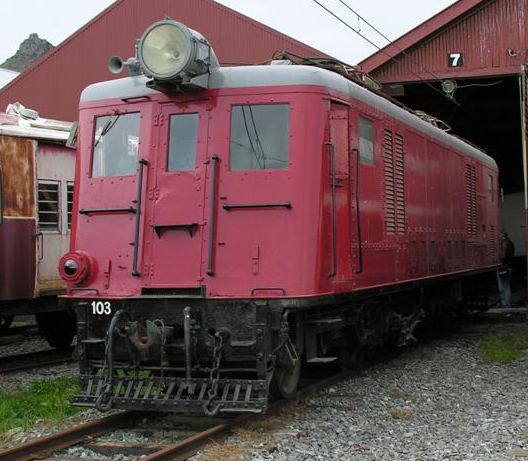Power type Electric Gauge 1,067 mm (3 ft 6 in) | UIC class 1-Do-2 Length 14.1 m (46 ft 3 in) | |
 | ||
Loco weight 89 short tons (81 t; 79 long tons) | ||
The New Zealand ED class locomotive was a class of electric locomotive used in Wellington, New Zealand. They were built by English Electric and the New Zealand Railways Department between 1938 and 1940, and hauled mainly passenger trains on the Wellington region's 1500 V DC electrification, and banked freight trains on the steep section between Paekakariki and Pukerua Bay.
Contents
The locomotives featured a unique wheel arrangement, 1-Do-2 under the UIC classification system, and incorporated a quill drive to the driving wheels.
They were found to be hard on the tracks, leading to speed restrictions on these locomotives and their replacement by EW class locomotives on the Johnsonville Line after the introduction of the EW in 1952. The EW was considered more suited to passenger services than the ED and replaced them on most passenger services on other lines.
Classification
Like all other electric locomotives in New Zealand, the leading letter of the locomotives' classification is E. There are two predominant theories about how the ED class acquired the second letter, D. The first is that it comes from the "Do" of its 1-Do-2 wheel arrangement. The second is from its original allocation to two locations, Wellington and Otira - Arthur's Pass, hence "duplicated". Official records provide no confirmation of either theory.
Introduction
New Zealand Railways purchased one ED class locomotive in 1938 from English Electric, No. 101, for use on the newly opened Tawa Flat deviation, which incorporated two long tunnels. This locomotive was known as The Sergeant because of the three longitudinal stripes on each side of the body that were unique to this locomotive.
The success of this locomotive led to the importation of locomotive components from the United Kingdom for assembly in New Zealand. A further seven locomotives were assembled at the Hutt Workshops and two at Addington Workshops for use on the Otira - Arthur's Pass section of the Midland Line. These locomotives were later transferred north.
Steam boilers
Each locomotive originally had oil-fired water-tube boilers for passenger carriage steam heaters, supplied by the Sentinel Wagon Works. However, the boiler, which could supply 1,250 pounds (570 kg) of steam per hour at a pressure of 40 pounds per square inch (280 kPa), appears not to have been used very often and was thus removed during their operational lives. The water and oil tanks had capacities of 400 and 500 imperial gallons (1,800 and 2,300 l) respectively, so could steam for four hours before refilling.
Withdrawal
With the introduction of DA class diesels on the Paekakariki via Pukerua Bay to Wellington electrified section in 1967, eight of the class were withdrawn from service in 1969 and scrapped. The remaining two were kept in sporadic service until March 1981, when both locomotives were sold into preservation. There were plans to send them back to the Otira - Arthurs Pass section but nothing came of this. ED 101 is preserved (on static display) by the Silver Stream Railway, while ED 103 is preserved by the Ferrymead Railway.
